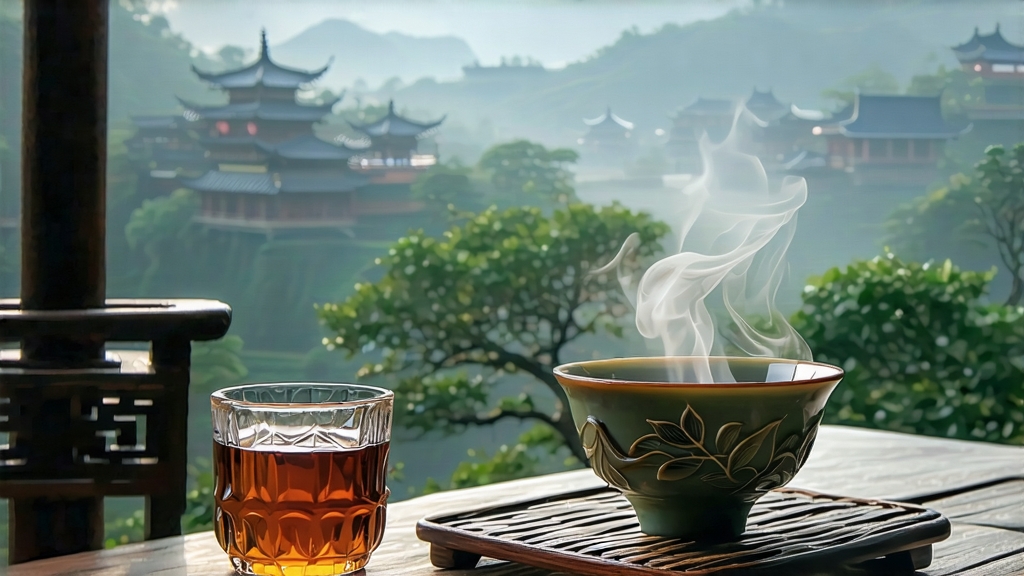
If oolong is the jazz of Chinese tea—improvisational, layered, forever balancing between green freshness and black depth—then Phoenix Dancong from Guangdong Province is the saxophone solo that makes the whole room fall silent. Unlike the more publicised Fujian oolongs such as Tie Guan Yin or Da Hong Pao, Phoenix Dancong (literally “single-bush”) remains a connoisseur’s secret outside China, yet within the Middle Kingdom it is venerated as the aromatic encyclopaedia of tea: one miniature leaf capable of evading lychee, jasmine, almond, cinnamon, or even ginger flower in a single steeping. This essay invites the international reader to travel the mist-crowned ridges of Fenghuang (Phoenix) Mountain, meet the 700-year-old mother trees, witness the perilous dance of 70-percent oxidation, and finally master the Chaozhou gongfu ritual that coaxes a thimbleful of liquor into a lingering aria.
-
Historical roots: from Song dynasty tribute to post-Mao renaissance
Local chronicles credit the She ethnic minority with discovering wild tea on Phoenix Mountain during the Southern Song (1127-1279). Imperial taste, however, canonised the tea in 1392 when the Hongwu Emperor accepted “Phoenix tribute” as part of the southern levies. Carried north along the Mei-ling Pass, the leaves were so fragrant that court poets claimed the aroma “arrived three days before the courier.” By the late Qing, merchants from Chaozhou port began charcoal-roasting the tea for oceanic voyages, inadvertently creating the deeper, honeyed profile that modern drinkers prize. The Cultural Revolution (1966-76) nearly erased the craft: ancient bushes were felled for grain terraces, and master roasters were reassigned to steel factories. Recovery began in 1982 when agronomist Huang Jian-xiang persuaded villagers to graft remaining mother-tree cuttings onto newly cleared slopes, effectively cloning the genetic perfume library locked inside each single-bush. -
Micro-terroir: why altitude 800-1200 m matters
Fenghuang Mountain is a granite spine thrust upward by the same tectonic collisions that birthed the Wuyi range 400 km north. Yet here the monsoon is warmer, the fog thicker, and the diurnal swing a dramatic 15 °C. Ultraviolet intensity at 1,000 m forces the tea plant to synthesise more aromatic esters—particularly geraniol and linalool—while the granitic sand drains so quickly that roots struggle, concentrating flavour. Locals summarise the terroir in four characters: 云 (cloud), 雾 (mist), 日 (sun), 石 (rock), a deliberate echo of the Wuyi mantra yet with subtropical humidity that yields fruitier cup profiles. -
Garden taxonomy: 80 aromatic profiles in one village
Unlike the clonal neatness of Japanese cultivars, Phoenix Dancong is still propagated by seed and then selected for fragrance, creating what botanists call a “landrace swarm.” Gardeners classify the bushes by their dominant aroma, giving rise to names that read like a spice-market poem: Honey Orchid (Mi Lan Xiang), Ginger Flower (Jiang Hua Xiang), Almond Fragrance (Xing Ren Xiang), Yellow Gardenia (Huang Zhi Xiang), and the rare Night-Blooming Jasmine (Ye Lai Xiang). Each name is not marketing but a sensory contract: when expertly roasted, the leaf must deliver the promised note without added flavouring. DNA bar-coding conducted at South China Agricultural University in 2019 confirmed that these are all Camellia sinensis var. sinensis, yet divergent chemotypes, proving that Chinese farmers had intuitively practised phenotype selection centuries before modern genomics. -
Plucking calendar: the knife versus the nail
The spring harvest begins when the first cicada sings—usually between Qingming and Grain Rain (early April). Only the middle 3 or 4 leaves are taken, leaving the purple bud intact for next flush. Pickers use a short, curved knife called cao dao rather than fingernails to avoid bruising the stem; the incision must be clean enough to “whistle” when spun in the air, ensuring oxidation will proceed evenly. A single 200-year-old tree yields at most 800 g of fresh